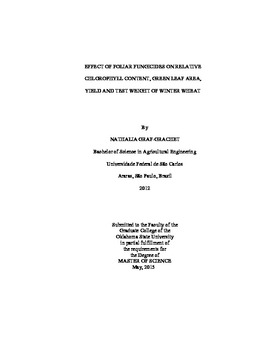| dc.contributor.advisor | Hunger, Robert | |
| dc.contributor.author | Graf-Grachet, Nathalia | |
| dc.date.accessioned | 2016-09-29T18:34:43Z | |
| dc.date.available | 2016-09-29T18:34:43Z | |
| dc.date.issued | 2015-05-01 | |
| dc.identifier.uri | https://hdl.handle.net/11244/45168 | |
| dc.description.abstract | Wheat (Triticum spp.) is an important cereal crop susceptible to many foliar diseases that reduce grain production. These diseases can be managed by fungicide application that alleviate grain yield loss from susceptible varieties and can increase grain yield of resistant varieties on occasion. The strobilurins represent a class of fungicides registered as `plant health' promoters that claim to provide beneficial properties other than disease control such as increased chlorophyll content. Additionally, the strobilurins have been shown to prevent spore germination, which serves to avoid triggering of the hypersensitive response in resistant varieties. As a result, plants maintain green leaf area for greater energy production and increased grain yield. Therefore, the objectives of this research were to determine if fungicide application to resistant varieties i) increased yield and test weight of wheat in the absence of disease in the field by resulting in increased chlorophyll content in flag leaves, and ii) increased chlorophyll content of leaves in the presence of leaf rust in a controlled environment. An irrigated and a dryland field trial planted in fall 2013 with `Duster' (resistant to foliar diseases) and `OK Bullet' (susceptible) hard red winter wheat were sprayed with three fungicides (a triazole, a strobilurin, and a combination) at labeled rates. Relative chlorophyll content was determined before and after fungicide application. Fungicides did not increase relative chlorophyll content and did not affect yield or test weight. In controlled environment studies, Duster and OK Bullet plants were sprayed with the same fungicides as used in the field, and inoculated with urediniospores of P. triticina (causal fungus of wheat leaf rust). Relative chlorophyll content was determined before and after fungicide application, and after inoculation. Green leaf area was determined at the end of the experiment. In these studies, sprayed-plants of both varieties had the same relative chlorophyll content as the non-sprayed and non-inoculated control plants indicating fungicide did not increase chlorophyll content. However, the early fungicidal action by the fungicides (especially the strobilurin fungicide pyraclostrobin) likely killed spores that prevented the induction of hypersensitive response resulting in greater maintenance of green leaf area. This could explain why resistant varieties occasionally show a yield response to a fungicide applied in the presence of foliar disease. | |
| dc.format | application/pdf | |
| dc.language | en_US | |
| dc.rights | Copyright is held by the author who has granted the Oklahoma State University Library the non-exclusive right to share this material in its institutional repository. Contact Digital Library Services at lib-dls@okstate.edu or 405-744-9161 for the permission policy on the use, reproduction or distribution of this material. | |
| dc.title | Effect of Foliar Fungicides on Relative Chlorophyll Content, Green Leaf Area, Yield and Test Weight of Winter Wheat | |
| dc.type | text | |
| dc.contributor.committeeMember | Damicone, John | |
| dc.contributor.committeeMember | Edwards, Jeffrey | |
| dc.contributor.committeeMember | Payton, Mark | |
| osu.filename | GrafGrachet_okstate_0664M_13903.pdf | |
| osu.accesstype | Open Access | |
| dc.description.department | Plant Pathology (PhD) | |
| dc.type.genre | Thesis | |
